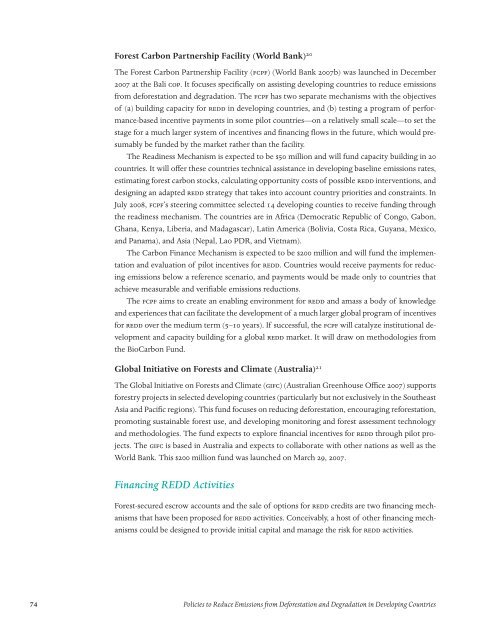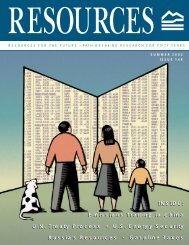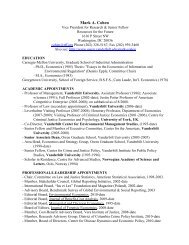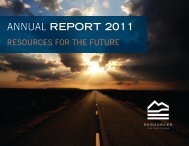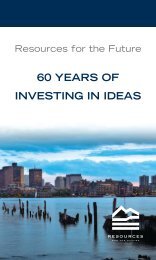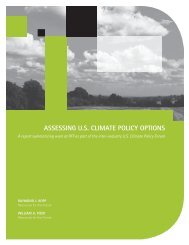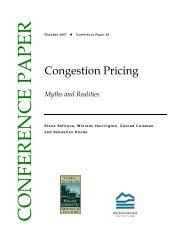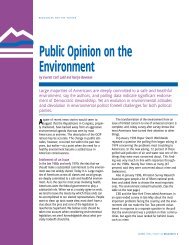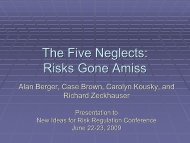Policies to Reduce Emissions from Deforestation and Degradation ...
Policies to Reduce Emissions from Deforestation and Degradation ...
Policies to Reduce Emissions from Deforestation and Degradation ...
You also want an ePaper? Increase the reach of your titles
YUMPU automatically turns print PDFs into web optimized ePapers that Google loves.
Forest Carbon Partnership Facility (World Bank) 20<br />
The Forest Carbon Partnership Facility (FCPF) (World Bank 2007b) was launched in December<br />
2007 at the Bali CoP. It focuses specifically on assisting developing countries <strong>to</strong> reduce emissions<br />
<strong>from</strong> deforestation <strong>and</strong> degradation. The FCPF has two separate mechanisms with the objectives<br />
of (a) building capacity for REDD in developing countries, <strong>and</strong> (b) testing a program of performance-based<br />
incentive payments in some pilot countries—on a relatively small scale—<strong>to</strong> set the<br />
stage for a much larger system of incentives <strong>and</strong> financing flows in the future, which would presumably<br />
be funded by the market rather than the facility.<br />
The Readiness Mechanism is expected <strong>to</strong> be $50 million <strong>and</strong> will fund capacity building in 20<br />
countries. It will offer these countries technical assistance in developing baseline emissions rates,<br />
estimating forest carbon s<strong>to</strong>cks, calculating opportunity costs of possible REDD interventions, <strong>and</strong><br />
designing an adapted REDD strategy that takes in<strong>to</strong> account country priorities <strong>and</strong> constraints. In<br />
July 2008, FCPF’s steering committee selected 14 developing counties <strong>to</strong> receive funding through<br />
the readiness mechanism. The countries are in Africa (Democratic Republic of Congo, Gabon,<br />
Ghana, Kenya, Liberia, <strong>and</strong> Madagascar), Latin America (Bolivia, Costa Rica, Guyana, Mexico,<br />
<strong>and</strong> Panama), <strong>and</strong> Asia (Nepal, Lao PDR, <strong>and</strong> Vietnam).<br />
The Carbon Finance Mechanism is expected <strong>to</strong> be $200 million <strong>and</strong> will fund the implementation<br />
<strong>and</strong> evaluation of pilot incentives for REDD. Countries would receive payments for reducing<br />
emissions below a reference scenario, <strong>and</strong> payments would be made only <strong>to</strong> countries that<br />
achieve measurable <strong>and</strong> verifiable emissions reductions.<br />
The FCPF aims <strong>to</strong> create an enabling environment for REDD <strong>and</strong> amass a body of knowledge<br />
<strong>and</strong> experiences that can facilitate the development of a much larger global program of incentives<br />
for REDD over the medium term (5–10 years). If successful, the FCPF will catalyze institutional development<br />
<strong>and</strong> capacity building for a global REDD market. It will draw on methodologies <strong>from</strong><br />
the BioCarbon Fund.<br />
Global Initiative on Forests <strong>and</strong> Climate (Australia) 21<br />
The Global Initiative on Forests <strong>and</strong> Climate (GIFC) (Australian Greenhouse Office 2007) supports<br />
forestry projects in selected developing countries (particularly but not exclusively in the Southeast<br />
Asia <strong>and</strong> Pacific regions). This fund focuses on reducing deforestation, encouraging reforestation,<br />
promoting sustainable forest use, <strong>and</strong> developing moni<strong>to</strong>ring <strong>and</strong> forest assessment technology<br />
<strong>and</strong> methodologies. The fund expects <strong>to</strong> explore financial incentives for REDD through pilot projects.<br />
The GIFC is based in Australia <strong>and</strong> expects <strong>to</strong> collaborate with other nations as well as the<br />
World Bank. This $200 million fund was launched on March 29, 2007.<br />
Financing REDD Activities<br />
Forest-secured escrow accounts <strong>and</strong> the sale of options for REDD credits are two financing mechanisms<br />
that have been proposed for REDD activities. Conceivably, a host of other financing mechanisms<br />
could be designed <strong>to</strong> provide initial capital <strong>and</strong> manage the risk for REDD activities.<br />
4 <strong>Policies</strong> <strong>to</strong> <strong>Reduce</strong> <strong>Emissions</strong> <strong>from</strong> <strong>Deforestation</strong> <strong>and</strong> <strong>Degradation</strong> in Developing Countries


